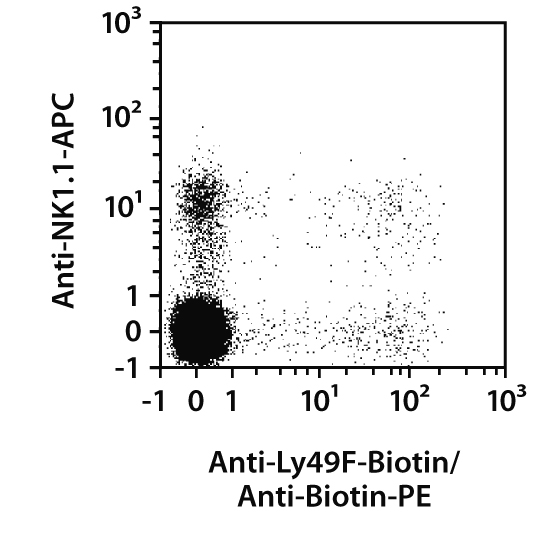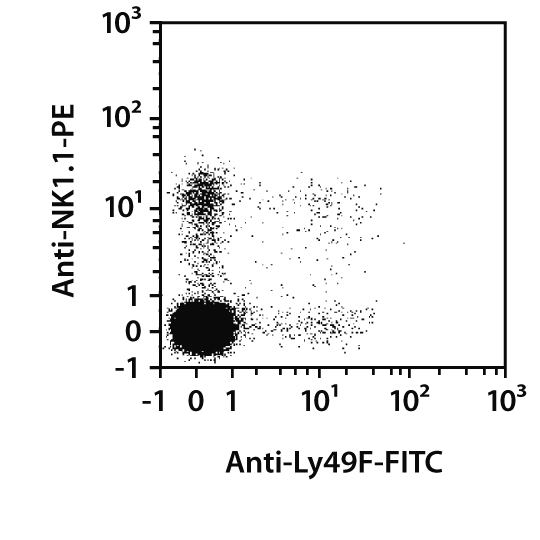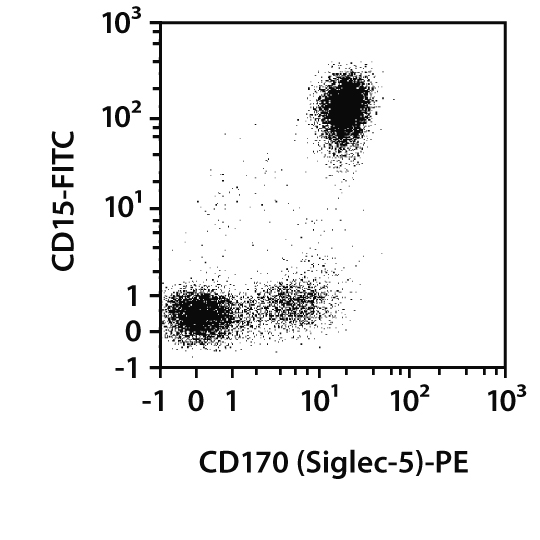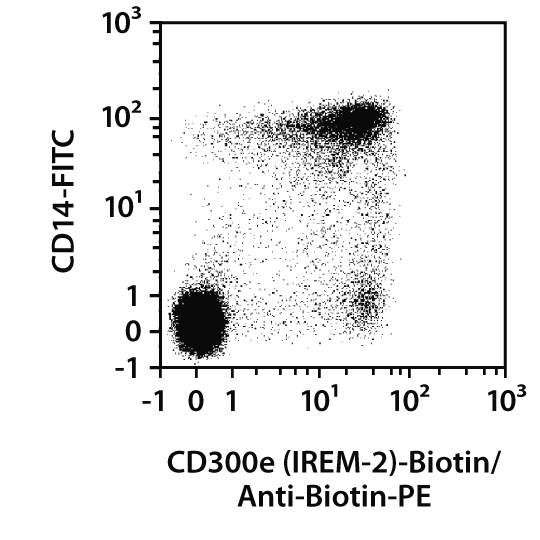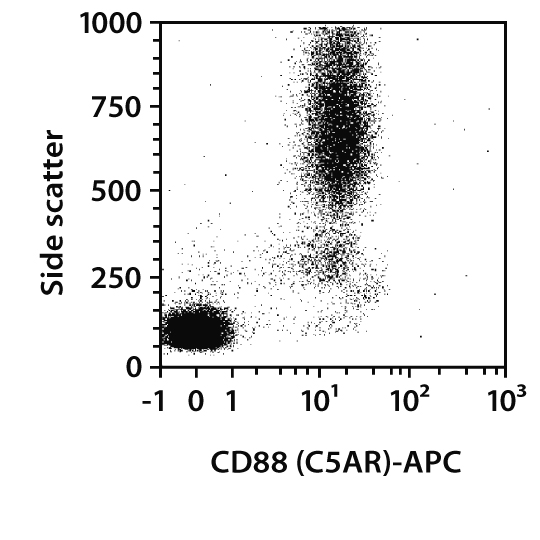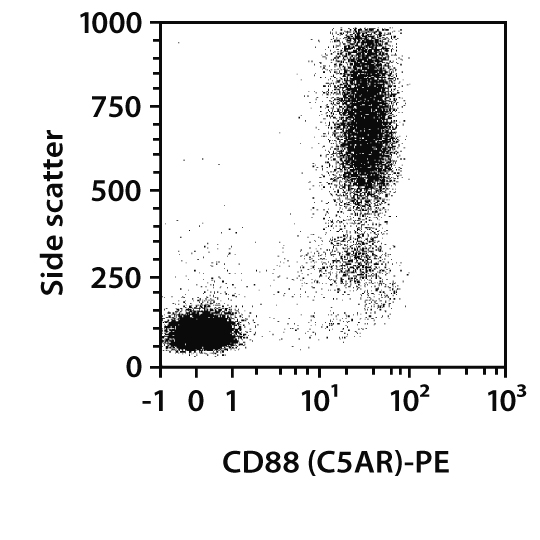Antibodies for flow cytometry
Code: 130-104-339
Overview
Clone HBF-719 recognizes the mouse killer cell lectin-like receptor 6 (Ly-49F) antigen, a type II transmembrane natural killer cell receptor belonging to the Ly-49 family. Members of the Ly-49 family are homodimeric C-type lectin receptors, recognizing MHC class I molecules as ligands and include activating and inhibitory receptor molecules. The inhibitory receptor Ly-49F is expressed on subsets of NK cells, NK-T cells, and on a subpopulation of memory T cells in C57BL/6 mice, but not AKR/J, BALB/c, C3H/HeN, DBA/1, or SJL mice. IL-21 selectively down-regulates Ly-49F on mature NK cells.
Alternative names
Klra6, Lymphocyte antigen 49f, T-cell surface glycoprotein Ly-49FSpecifications
- Biotin : 0
- Mouse : 0
- 60 tests : 0
- 9 µg in 300 µL : 0
- mouse IgG1 : 0
Code: 130-104-340
Overview
Clone HBF-719 recognizes the mouse killer cell lectin-like receptor 6 (Ly-49F) antigen, a type II transmembrane natural killer cell receptor belonging to the Ly-49 family. Members of the Ly-49 family are homodimeric C-type lectin receptors, recognizing MHC class I molecules as ligands and include activating and inhibitory receptor molecules. The inhibitory receptor Ly-49F is expressed on subsets of NK cells, NK-T cells, and on a subpopulation of memory T cells in C57BL/6 mice, but not AKR/J, BALB/c, C3H/HeN, DBA/1, or SJL mice. IL-21 selectively down-regulates Ly-49F on mature NK cells.
Alternative names
Klra6, Lymphocyte antigen 49f, T-cell surface glycoprotein Ly-49FSpecifications
- FITC : 0
- Mouse : 0
- 60 tests : 0
- 9 µg in 300 µL : 0
- mouse IgG1 : 0
Code: 130-101-810
Overview
Clone 1A5 recognizes the CD170 antigen, a single-pass transmembrane protein member of the immunoglobulin superfamily, also known as sialic acid-binding Ig-like lectin 5 (siglec-5). CD170 is expressed on neutrophils, monocytes, dendritic cells, and subsets of tissue macrophages. It contains two tyrosine-based motifs in its cytoplasmic tail implicating signaling functions and forms a 140 kDa dimer on the cell surface. Tyrosine phosphorylation of CD170 leads to recruitment of the tyrosine phosphatases SHP-1 and SHP-2, which in turn efficiently inhibits FcεRI-mediated calcium fluxing and serotonin release. CD170 binds α 2-3– and α 2-6–linked sialic acid as well as glycophorin A, and is involved in cell adhesion.
Alternative names
CD33L2, OB-BP2, OBBP2, Siglec-5Specifications
- Human : 0
- FITC : 0
- 100 tests : 0
- 1 mL : 0
- mouse IgG1 : 0
Code: 130-101-811
Overview
Clone 1A5 recognizes the CD170 antigen, a single-pass transmembrane protein member of the immunoglobulin superfamily, also known as sialic acid-binding Ig-like lectin 5 (siglec-5). CD170 is expressed on neutrophils, monocytes, dendritic cells, and subsets of tissue macrophages. It contains two tyrosine-based motifs in its cytoplasmic tail implicating signaling functions and forms a 140 kDa dimer on the cell surface. Tyrosine phosphorylation of CD170 leads to recruitment of the tyrosine phosphatases SHP-1 and SHP-2, which in turn efficiently inhibits FcεRI-mediated calcium fluxing and serotonin release. CD170 binds α 2-3– and α 2-6–linked sialic acid as well as glycophorin A, and is involved in cell adhesion.
Alternative names
CD33L2, OB-BP2, OBBP2, Siglec-5Specifications
- Biotin : 0
- Human, non-human primate : 0
- 100 tests : 0
- 1 mL : 0
- mouse IgG1 : 0
Code: 130-104-349
Overview
Clone ATM-2 recognizes the rat CD252 antigen, a member of the TNF ligand superfamily, also known as OX40 ligand (OX40L) or tumor necrosis factor ligand superfamily member 4 (TNSFSF4). CD252 is constitutively expressed by splenic dendritic cells and can be upregulated on splenic B cells via stimulation with LPS. Expression of the cognate receptor CD134 (OX40) is found predominantly on activated T cells. CD252/CD134 interaction promotes the proliferation and survival of effector T cells, modulates cytokine production, suppresses the activity of natural regulatory T cells, and inhibits the generation of inducible regulatory T cells.
Alternative names
TNFSF4, OX40LSpecifications
- PE : 0
- Rat : 0
- 60 tests : 0
- 9 µg in 300 µL : 0
- mouse IgG1 : 0
Code: 130-101-813
Overview
The monoclonal antibody UP-H2 reacts with human CD300e, also known as IREM-2, LMIR6, or CMRF35-A5. This 34 kDa activating receptor of the immunglobulin superfamily is expressed on mature myeloid dendritic cells and monocytes and is down-regulated on immature dendritic cells. CD300e interacts with DAP-12, which mediates acivating signals. It is reported that the alloreactive response of naive T cells is enhanced by IREM-2 activation of mDCs.
Alternative names
CD300LE, CLM-2, CMRF35-A5, IREM-2, PIgR-2, LMIR6Specifications
- Human : 0
- Biotin : 0
- 100 tests : 0
- 1 mL : 0
- mouse IgG1 : 0
Code: 130-104-333
Overview
Clone S5/1 recognizes the human CD88 antigen, a 43 kDa G type protein–coupled receptor with seven membrane-spanning regions which is also known as C5a anaphylatoxin chemotactic receptor 1 (C5AR). CD88 expression is originally described on neutrophils and monocyte/macrophages, but it is also found on hepatocytes, epithelial cells, endothelial cells, tissue mast cells, and human fetal astrocytes. Constitutive CD88 expression was also detected on astrocytes, microglia, and fibroblast-like cells but not by oligodendrocytes. CD88 is a receptor for the chemotactic and inflammatory peptide anaphylatoxin C5a. It stimulates chemotaxis, granule enzyme release, and superoxide anion production. Sulfation plays a critical role in the association of CD88 with C5a, but no significant role in the ability of CD88 to transduce a signal and mobilize calcium in response to a small peptide agonist.
Specifications
- Human : 0
- FITC : 0
- 30 tests : 0
- 0.3 ml : 0
- Mouse IgG2a : 0
Code: 130-104-334
Overview
Clone S5/1 recognizes the human CD88 antigen, a 43 kDa G type protein–coupled receptor with seven membrane-spanning regions which is also known as C5a anaphylatoxin chemotactic receptor 1 (C5AR). CD88 expression is originally described on neutrophils and monocyte/macrophages, but it is also found on hepatocytes, epithelial cells, endothelial cells, tissue mast cells, and human fetal astrocytes. Constitutive CD88 expression was also detected on astrocytes, microglia, and fibroblast-like cells but not by oligodendrocytes. CD88 is a receptor for the chemotactic and inflammatory peptide anaphylatoxin C5a. It stimulates chemotaxis, granule enzyme release, and superoxide anion production. Sulfation plays a critical role in the association of CD88 with C5a, but no significant role in the ability of CD88 to transduce a signal and mobilize calcium in response to a small peptide agonist.
Alternative names
C5AR1, C5A, C5AR, C5R1Specifications
- Human : 0
- PE : 0
- 30 tests : 0
- 0.3 ml : 0
- Mouse IgG2a : 0





